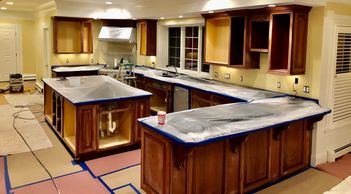All Veterans Receive 10% off!

Eat. Drink. Be Merry.
Kitchen & Cabinet Refinishing
“The kitchen really is the castle itself. This is where we spend our happiest moments and where we find the joy of being a family.” Mario Batali

Painting: Perfected.
Legacy Home Finishes has mastered the cabinet painting process to produce results with the same quality, often superior, as a factory finish for a fraction of the cost of replacing them
Installing new cabinets is expensive and a very intrusive process. In recent years, there have been major strides in water-based paint technology that have allowed applicators the ability to replicate finishes that were once only attainable by using toxic lacquers with volatile odors.

Revive, Protect, Recycle
If you are an eco-conscious homeowner, then refinishing your kitchen or bathroom cabinets is far more environmentally friendly than replacing them. After all, by ensuring that your existing cabinet boxes aren’t sent to the landfill, as well as guaranteeing that extra materials aren’t used in the production of new doors — you’ve effectively avoided contributing to any wasteful construction practices!

Your Kitchen, Your Style
The biggest downside to buying factory-made cabinets is the limited color selection. Do any of the dull, cookie-cutter selections at your local big box store speak to who you are? Why spend tens of thousands of dollars on a kitchen that three of your neighbors have? With the ability to choose the exact tone, gloss level, and hardware furnishings that suit your tastes, you're limited only by your inner-designer!
The Process
Disassembly

Labeling each door and drawer front is an essential first step to create a map of how to put your cabinets back together once they have been refinished. All hardware will be removed and stored separately to avoid mixing differently sized screws and hinges. All cabinets and drawer fronts will be taken off-site to receive the following steps in a controlled environment, while frames and boxes will be finished on-site.
Clean

The preparation phase is inarguably the most labor intensive step, but is also the key to a durable finish. Cutting corners here is where inexperienced painters go afoul; not even the strongest industrial epoxies will last very long if the substrate isn't prepped properly. Thats why we take extra care to deep-clean your cabinets prior to sanding to avoid grinding oils and greases permanently into the wood, ruining the primer's adhesive abilities.
Sand

Once we've achieved a squeaky clean cabinet surface, it's time to add some tooth. Aggressive sanding isn't usually necessary; a medium/fine grit sandpaper is all that is required to produce millions of micro grooves and valleys in the existing finish and provide a grip-positive plane for the primer to physically bond to.
Mask
Finish

We're refinishing your cabinets, not your countertops, sink, backsplash, and hardwood floor. The beauty of newly painted doors and drawers quickly fades to the background if your painter gets overspray and drips on areas that were supposed to be kept clean! Accidents can happen; and that's why we use plastic film and waterproof paper to keep those accidents from adhering to areas they shouldn't.
Prime
Finish
Finish

Primer contains special adhesives and resins that provide an advantage when trying to chemically bond to a slick surface. Given the abuse and daily use that kitchens receive, we skip the "paint and primer in one" marketing ploy and instead opt for highly specialized and surface-specific primer formulas. Which primer will be best suited to your cabinets will be decided at the time of estimation.
Finish
Finish
Finish

This is where the magic happens! Doors, drawers, and frames are now ready for their sprayed finish. Once your cabinets have received their top coat and given 24 hours to dry, your doors and drawers will be wrapped in bubble paper to protect them on their journey home where they'll be reinstalled in their original position using either previous or newly bought hardware.
Cookie Policy
This website uses cookies. By continuing to use this site, you accept our use of cookies.